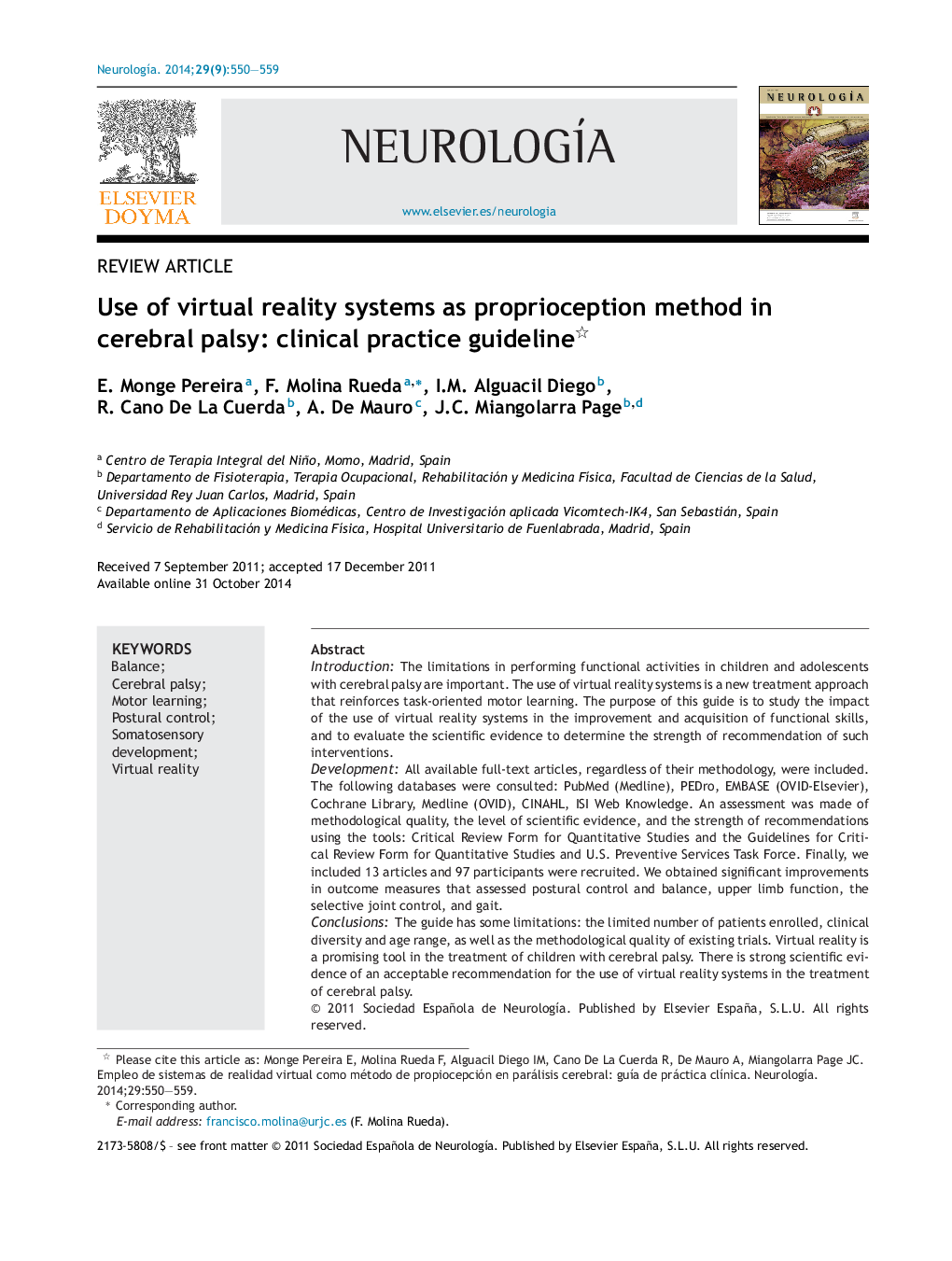| کد مقاله | کد نشریه | سال انتشار | مقاله انگلیسی | نسخه تمام متن |
|---|---|---|---|---|
| 3077375 | 1189139 | 2014 | 10 صفحه PDF | دانلود رایگان |

IntroductionThe limitations in performing functional activities in children and adolescents with cerebral palsy are important. The use of virtual reality systems is a new treatment approach that reinforces task-oriented motor learning. The purpose of this guide is to study the impact of the use of virtual reality systems in the improvement and acquisition of functional skills, and to evaluate the scientific evidence to determine the strength of recommendation of such interventions.DevelopmentAll available full-text articles, regardless of their methodology, were included. The following databases were consulted: PubMed (Medline), PEDro, EMBASE (OVID-Elsevier), Cochrane Library, Medline (OVID), CINAHL, ISI Web Knowledge. An assessment was made of methodological quality, the level of scientific evidence, and the strength of recommendations using the tools: Critical Review Form for Quantitative Studies and the Guidelines for Critical Review Form for Quantitative Studies and U.S. Preventive Services Task Force. Finally, we included 13 articles and 97 participants were recruited. We obtained significant improvements in outcome measures that assessed postural control and balance, upper limb function, the selective joint control, and gait.ConclusionsThe guide has some limitations: the limited number of patients enrolled, clinical diversity and age range, as well as the methodological quality of existing trials. Virtual reality is a promising tool in the treatment of children with cerebral palsy. There is strong scientific evidence of an acceptable recommendation for the use of virtual reality systems in the treatment of cerebral palsy.
ResumenIntroducciónLas limitaciones para realizar actividades funcionales en niños y adolescentes con parálisis cerebral son importantes. El empleo de sistemas de realidad virtual constituye un nuevo enfoque de tratamiento que refuerza el aprendizaje motor orientado a tareas. El objetivo del presente trabajo consiste en analizar qué repercusión tiene el empleo de sistemas de realidad virtual en la mejora y adquisición de habilidades funcionales; y evaluar la evidencia científica existente para determinar qué fuerza de recomendación tienen dichas intervenciones.DesarrolloSe incluyeron todos los artículos disponibles a texto completo independientemente de su metodología. Se consultaron las siguientes bases de datos: Pubmed (Medline), PEDro, Embase (OVID-Elsevier), Cochrane Library Plus, Medline (OVID), CINHAL, ISI web Knowledge. Se evaluaron la calidad metodológica, el nivel de evidencia científica y la fuerza de las recomenda-ciones con las herramientas: Critical Review Form-Quantitative Studies and the Guidelines for Critical Review Form-Quantitative Studies y U.S. Preventive Services Task Force. Finalmente, se incluyeron 13 artículos y se reclutó a 97 participantes. Se obtuvieron mejoras significativas en medidas de resultado que evalúan el control postural y el equilibrio, la funcionalidad del miembro superior, el control selectivo articular y la marcha.ConclusionesLa guía posee algunas limitaciones: número de pacientes reclutados, diversidad clínica y rango de edad; así como la calidad metodológica de los ensayos existentes. La realidad virtual es una prometedora herramienta en el tratamiento de nĩnos con parálisis cerebral. Existe evidencia científica con fuerza de recomendación aceptable para el empleo de sistemas de realidad virtual en el tratamiento de la parálisis cerebral. © 2011 Sociedad Espãnola de Neurología. Publicado por Elsevier España, S.L. Todos los derechos reservados.
Journal: Neurología (English Edition) - Volume 29, Issue 9, November–December 2014, Pages 550–559